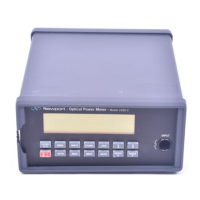14
4.2.2 Quantum Detector Temperature Effects
Semiconductor based photodiode detector characteristics (Newport
Corporation Low-Power detectors) are significantly affected by tempera-
ture. At longer wavelengths, these quantum detectors typically lose sensi-
tivity with increasing temperature. However the detector dark current
increases exponentially with temperature. For silicon detectors, dark
current is generally on the order of a few picoamps at room temperatures.
With uncooled germanium detectors, however, this dark current is on the
order of a nanoamp, or typically 1,000 to 10,000 times greater than silicon.
These dark currents can be zeroed at any moment in time via the ZERO key
on the 1830-C. Since dark currents drift with temperature, the ZERO should
be adjusted just prior to taking any measurements. The noise or drift in the
dark current sets a lower bound on the measurement resolution which can
be achieved with any given detector.
If the detector temperature is constant, sensitivity changes and dark
current drifts are significantly reduced. In addition, if the detector is
cooled, the dark current and dark current noise will decrease. For the most
accurate measurements, particularly with germanium detectors, the user
can cool the detector to approximately 0 °C and control the temperature to
within ± 1 °C.
4.2.3 Ambient and Stray Light
Ambient and stray light striking the detector will be measured by the 1830-
C, and should be considered when making sensitive measurements. Ambi-
ent light can be distinguished from dark current (or the detector/meter
noise floor) by turning off or blocking the source and covering the detector
face with an opaque material such as a piece of black metal. Using the
human hand to cover the detector is not advised because it emits a signifi-
cant amount of infrared radiation, and because it radiates a temperature
significantly different from ambient. With the detector covered, a reading of
the dark current may be made. Next, remove the material which is covering
the detector and take another reading. The difference is the ambient light
level.
The effects of ambient light are greatly reduced when using a fiber-
connectorized signal input to the detector. If free-space beam measure-
ments are desired, using an attenuator (Low-Power detectors have an OD3
attenuator included) will reduce stray light and often improve the source
signal to ambient signal noise level. Wavelength-specific filters, such as
optical cutoff, bandpass, or spike filters can also be used if the signal
wavelength spectrum permits. Other techniques to reduce stray light
include using apertures, placing the detector in a box or other housing to
shield the surface from light which is not coming from the source, and
turning off room and other lights.
NOTE
Changes in ambient light levels can occur from such factors as
turning room lights on or off, or by moving people or equipment. Remem-
ber, if you can see your detector element, then your detector can see the
light bouncing off your shirt!

